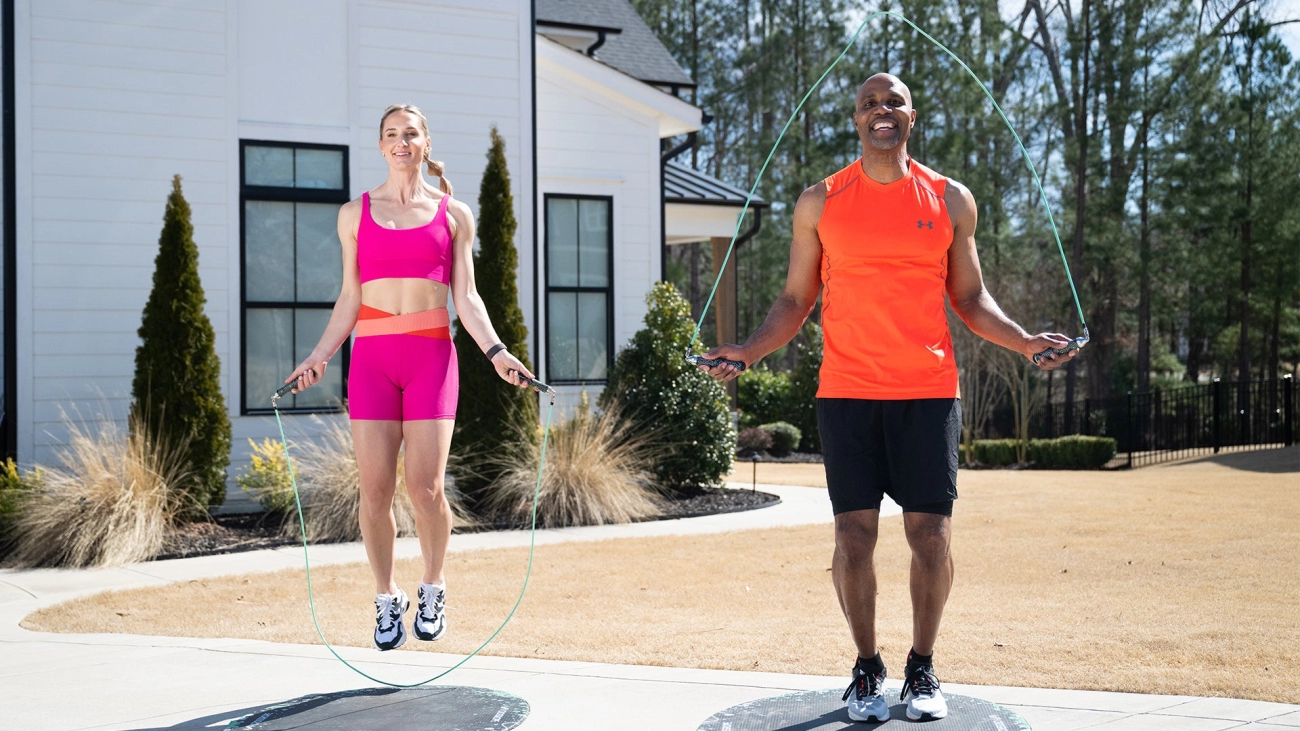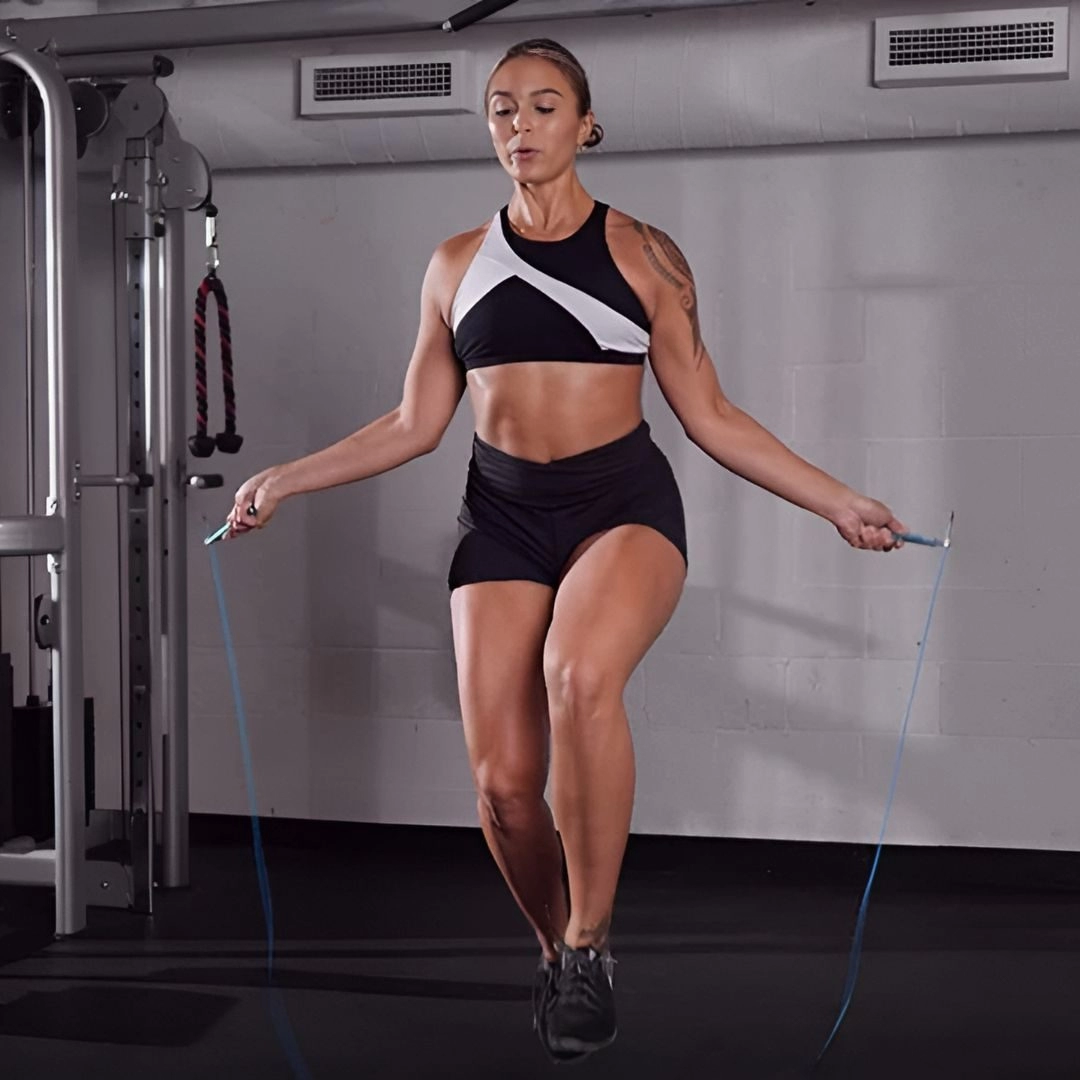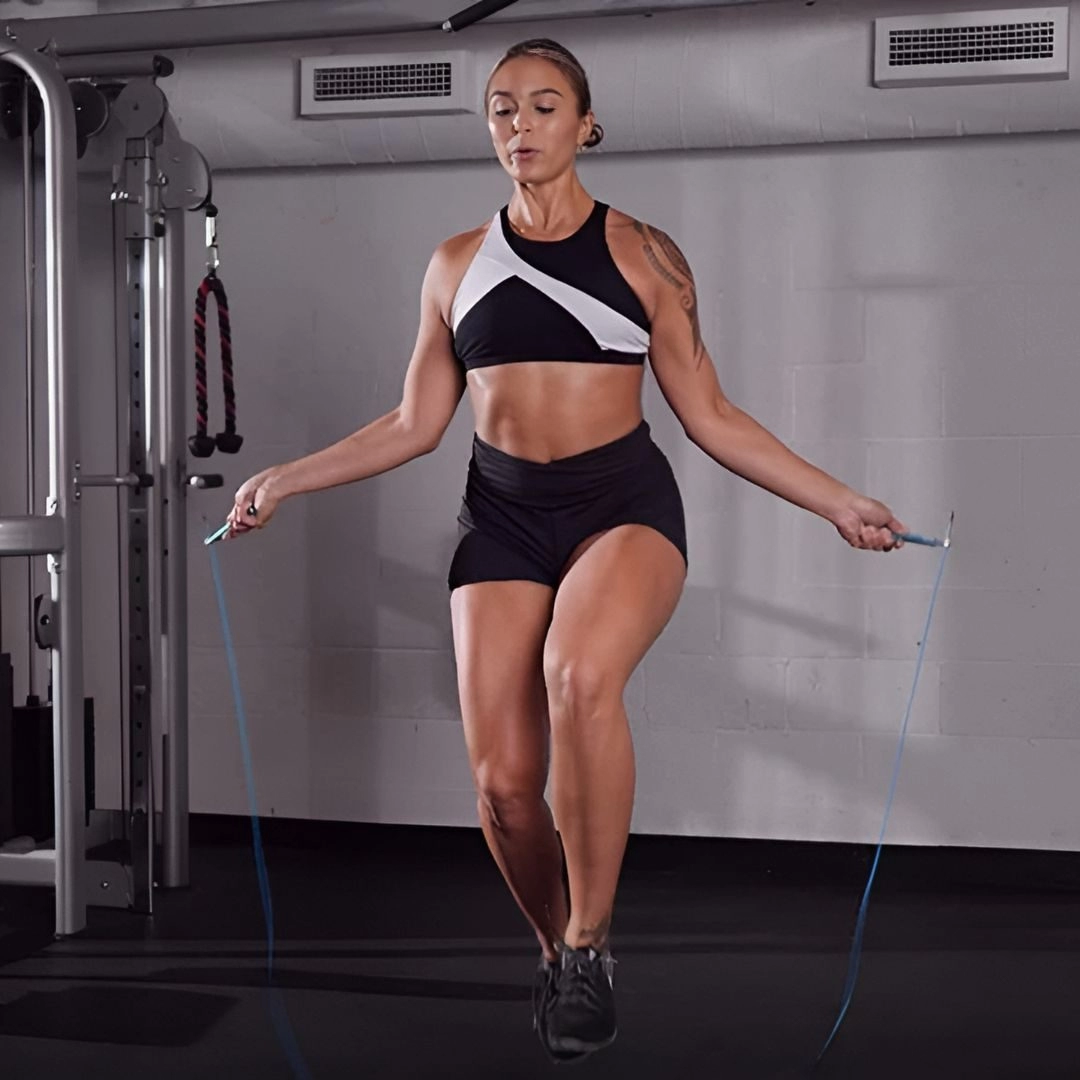Skipping Rope versus Rebounding Basics Overview
What is Skipping Rope and How It Works
Skipping rope, also known as jump rope, is a simple yet highly effective cardiovascular workout. It involves swinging a rope over the head and under the feet in continuous jumps. This exercise requires rhythm, coordination, and timing to maintain a smooth flow. Skipping rope activates your heart rate quickly and can be performed almost anywhere, making it a popular choice for weight loss and fitness training.
Typical equipment for skipping consists of the jump rope itself, which can vary greatly in design:
- PVC jump ropes for durability and speed
- Beaded jump ropes that offer noise and rhythm feedback
- Lightweight adjustable ropes suited for all skill levels
The materials and design profoundly affect the skipping experience, from speed training to endurance workouts.
What is Rebounding and How It Works
Rebounding refers to aerobic exercise performed on a mini trampoline, known as a rebounder. Unlike skipping rope, rebounding is a lower-impact activity where you bounce gently or vigorously on a cushioned surface. The trampoline absorbs much of the shock, making it easier on the joints while still offering cardiovascular benefits.
The typical rebounding equipment includes:
- A mini trampoline or rebounder (usually around 36 inches in diameter)
- Variants range from foldable home models to sturdier gym-grade rebounders
- Stability bars are sometimes added for balance support, especially for beginners or older adults
Rebounding works by providing a rhythmic bounce that engages the lymphatic system, improving circulation along with heart health.
Historical Context and Popularity Trends
Both skipping rope and rebounding have roots stretching back decades but cater to slightly different audiences.
- Skipping rope has long been favored by athletes and boxers for speed, agility, and cardio conditioning. It’s been part of physical education and training programs worldwide for over a century. Its portability and simplicity have kept it a classic fitness staple.
- Rebounding gained traction more recently, initially popularized by NASA in the 1980s for its low-impact benefits to astronauts’ bone density and muscle health in zero gravity. Since then, it’s found a dedicated following in the wellness community for joint-friendly cardio and lymphatic health.
Today, both are growing in popularity among fitness enthusiasts in the U.S. seeking efficient, fun, and affordable cardio options. Skipping rope appeals to those who want intense calorie burning with minimal gear, while rebounding attracts users looking for gentle exercise with added balance and stability benefits.
- Skipping rope is fast, high-impact, and versatile cardio fitness with simple, portable equipment.
- Rebounding offers low-impact, joint-friendly exercise using a mini trampoline that enhances circulation and balance.
Both continue to thrive, each serving unique fitness needs and preferences.
Health and Fitness Benefits Comparison Skipping Rope VS Rebounding

Cardiovascular Benefits and Endurance
Both skipping rope and rebounding offer strong cardiovascular benefits by getting your heart rate up and improving overall endurance. Skipping rope is a high-intensity cardio workout that rapidly increases heart rate, making it great for boosting heart health and stamina fast. Rebounding, on the other hand, provides a gentler, steady cardio effect that still improves heart function but with less strain.
- Skipping rope excels in short bursts of intense activity, improving anaerobic fitness and endurance.
- Rebounding exercise suits those aiming for consistent, moderate cardio, which helps maintain heart health over time.
Calories Burned Skipping Rope Versus Rebounding
When it comes to calorie burn, skipping rope generally burns more calories per minute due to its high-impact, fast-paced nature. Research shows that jumping rope can burn around 10-16 calories per minute depending on intensity and body weight. Rebounding burns fewer calories, roughly 5-12 calories per minute, but is more sustainable for longer sessions.
- Choose skipping rope for quick fat burn and weight loss goals.
- Choose rebounding for steady calorie burning with lower impact on joints.
Muscle Engagement and Targeted Groups
Skipping rope activates multiple muscle groups, especially in the lower body and core: calves, quads, hamstrings, glutes, and abs work hard to keep you jumping and balanced. The arms and shoulders also get a workout from continuously rotating the rope.
Rebounding engages similar lower-body muscles but with less intensity. It also improves core stabilization to maintain balance on the trampoline.
- Skipping rope strengthens legs, core, and upper body.
- Rebounding enhances leg strength, core stability, and proprioception.
Coordination and Balance Improvements
Both exercises boost coordination and balance but in different ways:
- Skipping rope requires timing, rhythm, and fast footwork, sharpening hand-eye coordination and agility.
- Rebounding improves balance by forcing you to stabilize on a moving surface, which enhances proprioception and joint control.
Impact on Bone Density and Joint Health
Skipping rope is a weight-bearing exercise that can help increase bone density, making it beneficial for bone health in active individuals. However, it is high impact and may stress joints, especially knees and ankles, if not done correctly or if you have pre-existing joint issues.
Rebounding is widely recognized for being a low-impact cardio exercise that’s gentler on joints while still offering bone-strengthening benefits through repetitive controlled movements. It’s often recommended for people with arthritis or joint sensitivity.
- Skipping rope builds bones but poses more joint stress risk.
- Rebounding promotes joint health without excess impact and supports bone density.
By weighing these health and fitness benefits, you can see why skipping rope suits those after intense cardio and calorie burn, while rebounding is excellent for joint-friendly workouts with cardiovascular and coordination improvements.
Impact on Joints and Injury Risk Skipping Rope vs Rebounding
When comparing skipping rope and rebounding, one of the biggest differences lies in how each affects your joints and the risk of injury. Understanding this can help you pick the best workout for your fitness level and goals.
Low Impact Nature of Rebounding
Rebounding workouts use a mini trampoline, which provides a soft, cushioned surface that absorbs most of the impact forces. This means:
- Less stress on knees, ankles, and hips compared to hard surfaces.
- It’s a great option if you have joint concerns or arthritis.
- The gentle bounce also helps improve balance and coordination without harsh strain.
This makes rebounding well-suited for older adults, beginners, or those recovering from injury who still want cardiovascular and muscular benefits without pounding their joints.
High Impact Nature of Skipping Rope
Skipping rope is a high-impact exercise because you’re repeatedly jumping and landing on a hard floor. This can lead to:
- Increased pressure on the joints, especially knees, shins, and ankles.
- A higher risk of issues like shin splints, joint pain, or stress fractures if your form or surface is poor.
- Fast footwork improves agility and coordination, but it doesn’t come without wear on your body.
Skipping rope is excellent for those with good joint health, younger users, or athletes looking for speed and power workouts. Proper shoes and technique are vital to reduce injury risk.
Injury Risks Specific to Each Exercise
- Skipping Rope
- Common injuries: ankle sprains, shin splints, knee pain
- Causes: poor technique, wrong surface, overtraining
- Rebounding
- Common injuries: falls from the trampoline, ankle twists
- Causes: loss of balance, improper trampoline setup, overuse
Suitability for Age Groups and Fitness Levels
| Exercise | Best For | Considerations |
|---|---|---|
| Rebounding | Seniors, beginners, joint issues | Low impact, easy on joints, safer overall |
| Skipping Rope | Younger adults, athletes, weight loss | Requires good joint health, higher intensity |
Bottom line: If joint protection and low injury risk are priorities, rebounding is your safer bet. If you want high-intensity training and have healthy joints, skipping rope offers unmatched cardio and muscle engagement.
Equipment and Cost Considerations for Skipping Rope and Rebounding
When choosing between skipping rope and rebounding, understanding the equipment costs, durability, and convenience is key. Let’s break it down so you know what fits your budget and lifestyle best.
Cost of Skipping Rope Equipment
- Quality skipping ropes can start as low as $10 for basic PVC ropes, but if you want something built to last with smoother rotation and better grip (like beaded jump ropes or speed ropes), prices range from $20 to $50.
- For users on a budget, good skipping ropes are very affordable and accessible for all ages and fitness levels.
- Replacement parts like handles or cables are easy and inexpensive to find, making it a low-cost long-term option.
- Skipping ropes require little to no extra space—you just need a flat area without obstructions.
Cost of Rebounding Equipment
- Mini trampolines or rebounders typically cost between $50 and $200, depending on size, brand, and features like foldability or adjustable resistance.
- Compared to skipping ropes, rebounders are a bigger initial investment and require more space for use and storage, usually around 3-4 feet of clearance.
- This equipment is bulkier, so ideal for home gyms but less practical for travel or small apartment use.
- Some higher-end rebounders include features to enhance workout versatility but add to the price.
Durability and Maintenance
- Skipping ropes are generally low maintenance. High-quality ropes resist fraying and have bearings that support smooth rotation. Just avoid rough surfaces that can wear the cable.
- Rebounders need occasional inspection of springs, mat, and frame tightness. The mats can wear out and might need replacement after heavy use.
- Both pieces of equipment are durable, but skipping ropes don’t require as much upkeep.
Portability and Convenience
- Skipping ropes are ultra portable. They weigh almost nothing, fit easily in a gym bag, and work well anywhere—indoors, outdoors, or on the go.
- Rebounders are less portable. While some foldable mini trampolines exist, they still demand space and effort to move, making them best suited for stable workout environments.
- If you travel frequently or want a quick workout anywhere, skipping rope is the clear winner.
| Factor | Skipping Rope | Rebounding |
|---|---|---|
| Cost | $10 – $50 | $50 – $200 |
| Space Requirement | Minimal | Moderate |
| Durability | High, low maintenance | Durable but requires care |
| Portability | Highly portable | Limited portability |
| Suitable For | All budgets, travel, gyms | Home use, stable workout areas |
In the U.S., where space and budget can vary widely, skipping ropes offer a low-cost, flexible option, while rebounders suit those prioritizing joint care and home workouts with room to spare.
Ease of Learning Skipping Rope vs Rebounding Beginner Accessibility

Skipping Rope Learning Curve and Tips
Skipping rope requires coordination and timing to master the basics. For most beginners, jumping rope feels awkward at first because you need to sync your jumps with the rope swings. Common challenges include tripping on the rope and managing speed. However, with consistent practice, you’ll quickly improve.
- Start with basic two-foot jumps on flat ground.
- Use a lightweight, adjustable jump rope (PVC ropes are great for beginners).
- Practice in short intervals, gradually increasing time.
- Watch out for common mistakes like jumping too high or poor wrist movement.
- Focus on steady rhythm rather than speed initially.
Once you get comfortable with the basics, you can add more skills like alternate foot steps, double unders, or criss-cross moves. It’s a great way to boost cardio and coordination once the basics stick.
Getting Started with Rebounding for Beginners
Rebounding is much more beginner-friendly because it’s low impact and easy to control. You simply bounce on the mini trampoline at your own pace. This makes it accessible for almost all fitness levels—from seniors to athletes.
- Start with simple bounces in place to get used to the feel.
- Progress to light jogging or jumping jacks on the rebounder.
- Use beginner-friendly routines that last 10-15 minutes.
- Follow guided workouts to improve balance and lymphatic stimulation gradually.
- Rebounding exercises rarely require complex skills or timing, which reduces frustration.
Because of its gentle nature, rebounding works well as a warmup or recovery workout and is ideal if you prefer a low impact cardio option.
Recommendations for Different User Levels
- Beginners: Rebounding offers a smoother start with less risk of tripping or discomfort. If balance or joint issues are concerns, start here.
- Beginners ready for a challenge: Try basic skipping rope drills to jumpstart coordination and higher intensity cardio.
- Advanced users: Both skipping and rebounding can be tailored for tougher sessions. Skipping rope supports HIIT and plyometric workouts, while rebounding improves endurance and balance training with low joint stress.
- Combining both: Using skipping rope and rebounder together offers variety and covers both high-impact intensity and low-impact recovery benefits.
Overall, skipping rope demands a bit more skill and practice, but it’s rewarding for high-intensity use. Rebounding wins for ease of use and accessibility, especially for beginners or those seeking gentle cardio options.
Workout Variety and Adaptability Skipping Rope VS Rebounding
Skipping Rope for High Intensity and Plyometric Workouts
Skipping rope shines when it comes to high intensity interval training (HIIT), endurance, and plyometric workouts. Its fast pace and rhythm naturally push your cardiovascular system and muscles to work harder, making it perfect for:
- HIIT sessions: Alternate between fast rope jumping and brief rest to maximize calorie burn and improve stamina.
- Endurance building: Long, steady-paced jumping boosts cardiovascular health and muscular endurance.
- Plyometric training: Intense jumps and quick footwork help improve explosive power, agility, and speed.
The versatility of skipping rope lets you mix foot patterns, speeds, and jump styles—for example, double unders or crisscrosses—which keeps workouts fresh and challenging.
Rebounding for Low Impact Cardio and Balance
Rebounding offers a low impact cardiovascular workout that’s gentle on your joints but still effective. It’s especially good for:
- Low impact cardio: The springy surface reduces impact forces, making it easier on knees and hips.
- Lymphatic system benefits: The gentle vertical movement helps stimulate lymph flow, aiding detox and immune function.
- Balance and coordination: The mini trampoline surface demands subtle muscle engagement to stay steady, improving balance and neuromuscular control.
Rebounding routines can include gentle bouncing, jogging in place, or more dynamic moves like twists, accommodating various fitness levels with low injury risk.
Combining Skipping Rope and Rebounding for a Balanced Routine
Using both skipping rope and rebounding creates a well-rounded workout plan that taps into the unique benefits of each. For example:
- Warm up with rebounding to get your joints moving and activate your lymphatic system.
- Follow with skipping rope intervals to boost heart rate and build endurance.
- Use rebounding for cool-down or balance-focused exercises to improve recovery and stability.
This combo delivers a mix of high intensity training and low impact movement, making it suitable for users wanting versatility, injury prevention, and effective fat loss.
skipping rope excels at high-intensity cardio and plyometrics, perfect for those focused on speed, agility, and calorie burn. Rebounding, meanwhile, suits people looking for gentle cardio, lymphatic health, and balance training. Combining both can help you build a varied, effective workout routine tailored to your individual fitness goals.
Real Life Application and User Preference Skipping Rope VS Rebounding

When deciding between skipping rope and rebounding exercise, it really boils down to your personal goals, lifestyle, and fitness needs. Both have their perks, but knowing who benefits most from each can help you pick the right fit.
Who Should Choose Skipping Rope
- Weight Loss and Calorie Burn: Skipping rope is a top choice if you want to shed pounds quickly. It torches calories fast thanks to its high-intensity, full-body nature.
- Speed and Agility Training: Athletes and fitness buffs use skipping to boost footwork, reflexes, and overall agility. It’s a favorite in boxing, CrossFit, and HIIT workouts.
- Portability and Convenience: If you travel a lot or want a workout anywhere, a skipping rope is lightweight and easily packed in a bag.
- Skill and Coordination Challenge: Those who like skill development and rhythm find skipping engaging and motivating.
Who Should Choose Rebounding
- Joint Protection and Low Impact Cardio: If you’re dealing with joint pain, arthritis, or recovering from injury, rebounding offers a gentle, low impact cardio option that’s easier on knees and hips.
- Lymphatic System Stimulation: Rebounding is great for improving lymph flow, which helps detoxify the body and supports immune health.
- Balance and Core Stability: It’s ideal for seniors, beginners, or anyone working on balance, coordination, and light cardio without stressing joints.
- Home Use and Space Savers: Mini trampolines are compact but do need a bit more space than a jump rope, making them great for home workouts when you want something stable and supportive.
User Testimonials and Brand Feedback
Many users of JumpRopeWholesale’s quality skipping ropes praise the durability and smooth rotation that helps them stick to their intense workout routines. One customer mentioned, “I lost 15 pounds in three months just by adding rope workouts to my mornings. Plus, the rope’s light weight makes on-the-go training easy.”
On the rebounding side, users report noticeable improvements in joint comfort and energy levels. A typical comment is, “Rebounding helped me stay active without the pain I got from running. It’s now my go-to low impact workout at home.”
Choosing between skipping rope and rebounding depends on your fitness priorities—fast calorie burn and agility vs. joint-friendly cardio and lymphatic health. Both have strong communities supporting their benefits and can be tailored to fit your lifestyle.
Why Choose JumpRopeWholesale for Your Skipping Rope Needs
When it comes to finding the best skipping rope for fitness, JumpRopeWholesale stands out as a reliable partner in the US market. As a leading skipping rope manufacturer and supplier, they focus on delivering high-quality jump ropes that suit a wide range of users—from beginners to advanced athletes.
Manufacturing Quality and Product Variety
JumpRopeWholesale uses durable materials like PVC jump ropes and beaded jump ropes designed for longevity and smooth performance. Their ropes are built to handle intensive workouts, making them ideal for both casual fitness enthusiasts and serious jumpers.
They offer a variety of styles and lengths so you can pick the perfect rope tailored to your height, skill level, and training goals. Plus, they provide OEM/ODM customization options, which is a big plus for retailers or fitness brands wanting to add a personal touch or logo to their skipping ropes.
Customer Service and Support
Customer experience is a priority. JumpRopeWholesale offers responsive support for both individual fitness users and retailers. This ensures you get the right guidance on choosing ropes, techniques, or maintaining your equipment.
Whether you’re ordering for personal use or stocking a gym, they make the buying process smooth, with quality checks and fast shipping geared toward US customers’ needs.
How Premium Skipping Ropes Enhance Your Workout
Using a premium skipping rope from JumpRopeWholesale improves your workout in several ways:
- Better control and smoother swings help you jump longer without frustration.
- Reliable ropes reduce the risk of breakage during high-intensity sessions.
- Ergonomic handles and quality bearings enhance grip and speed for interval training.
- Consistent performance boosts motivation and workout enjoyment, helping you stick to your fitness goals.
If you’re serious about skipping rope for weight loss, cardiovascular health, or improving coordination, investing in a reputable skipping rope is worth it. JumpRopeWholesale offers exactly that—a combination of quality, variety, and service tailored for the US fitness market.



